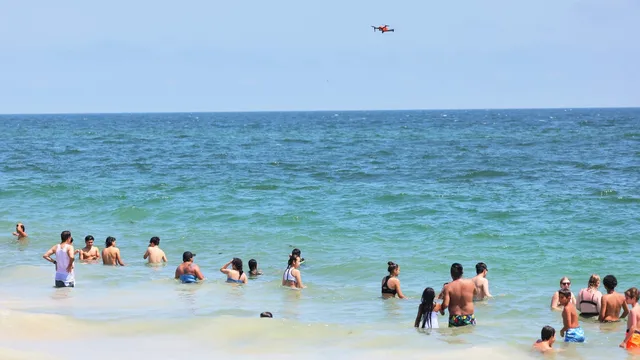
Shark sightings close New York beaches during busy July 4 weekend
2025-07-06 11:29- Sharks were spotted near beachgoers in New York City, leading to temporary beach closures.
- A shark bite incident occurred involving a 20-year-old woman earlier this summer.
- Authorities are enhancing shark monitoring to ensure beach safety for swimmers.
Express your sentiment!
Insights
During the Fourth of July holiday weekend in the United States, New York witnessed a surge in shark sightings along its beaches, prompting several temporary closures to ensure the safety of beachgoers. The heightened presence of sharks has raised concerns, especially with a shark bite incident involving a 20-year-old woman, who sustained minor lacerations while swimming. City officials reported multiple shark sightings in locations such as Rockaway Beach and Far Rockaway, encouraging residents and visitors to stay alert and follow safety measures outlined by lifeguards and park staff. Authorities in New York have ramped up safety measures, deploying drones to monitor shark activity. The state’s drone fleet comprised nearly 30 drones aimed at detecting marine life that might pose a risk to swimmers. Governor Kathy Hochul emphasized the importance of these measures, encouraging beachgoers to keep safe and staying proactive in observing safety guidelines. With waters warming up, experts indicated that the reshaping marine life in coastal areas may lead to an increase in shark encounters, although they assert that shark attacks remain rare in the U.S. Despite the presence of sharks, officials stressed that the chance of serious incidents occurring is low. Expert opinions highlighted that sharks do not consider humans as prey, but rather, they may bite out of curiosity. The measures in place are not only to protect beachgoers but also to ensure that citizens can enjoy their holiday atmosphere. As New Yorkers have always cherished their beaches, leaders are committed to maintaining these treasured environments while keeping everyone informed and safe. As the city navigates through this holiday season, precautions remain a top priority, especially with summer shining brightly. With the heightened shark activity, local authorities plan to continue monitoring beach areas closely. By deploying professional surf monitoring teams and utilizing drone technology, New York aims to mitigate potential risks and maintain the safety of its beaches as families and individuals come forth to celebrate the season on the shores.
Contexts
Historical shark attacks in New York and New Jersey have garnered attention due to their rarity and the increasing interest in coastal activities. Despite the vastness of the Atlantic Ocean and the significant shark populations that inhabit these waters, shark attacks in this region remain infrequent when compared to other coastal areas in the United States. The statistics indicate that the number of attacks is relatively low, with usually only a handful of incidents occurring each year, many of which are non-fatal. Understanding the historical context of these attacks is essential for developing safety protocols for beachgoers and surfers, as well as for promoting awareness of marine life in these waters. The history of shark attacks in New York and New Jersey dates back to the early 20th century. One notable incident was the series of attacks in 1916, commonly referred to as the Jersey Shore shark attacks, which included several confirmed attacks, some resulting in fatalities. This unusual increase in shark activity during a singular event led to widespread fear and a wave of public panic, resulting in the implementation of protective measures like shark nets and public education campaigns on sea safety. Over the decades, occasional attacks have occurred, but they are seldom lethal and are often attributed to mistaken identity, where sharks, primarily juvenile species, misidentify humans as prey due to their splashing movements in the water. The scientific community has sought to study the factors contributing to shark behavior in the region. Researchers note that the fluctuations in prey availability, particularly schools of fish and seals, can lead to increased shark activity. Moreover, environmental changes, such as warming waters due to climate change and habitat alterations due to urban development, can impact shark behavior and movement patterns. These studies underscore the need for continued research and surveillance to understand better how to coexist with these important marine predators. In recent years, conservation efforts have also been intensified in response to declining shark populations, promoting their protection while also ensuring public safety. Public awareness campaigns and educational initiatives on shark safety have become integral parts of beach management practices. Areas with higher reports of shark sightings often implement measures to minimize risks, including increased lifeguard patrols and informational signage. Additionally, advancements in technology, such as tracking devices and drones, help monitor shark movements, allowing for timely notifications to swimmers and surfers. It is essential for the public to remain informed about shark behavior and for authorities to strike a balance between beachgoer safety and the preservation of marine ecosystems. Continual dialogue between researchers, conservationists, and local communities is vital to fostering a safer environment while respecting the natural habitat of sharks and their role in the marine ecosystem.